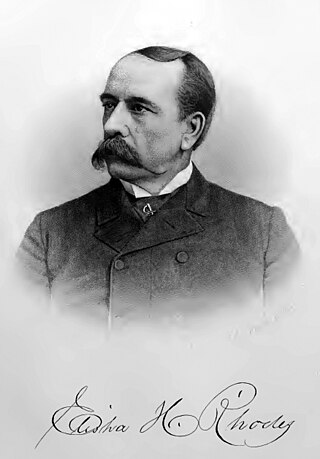Related Research Articles

Elisha Hunt Rhodes was an American soldier who served in the Union Army of the Potomac for the entire duration of the American Civil War, rising from corporal to colonel of his regiment by war's end. Rhodes' illustrative diary of his war service was quoted prominently in Ken Burns's 1990 PBS documentary series The Civil War, read by Chris Murney.

West Point Cemetery is a historic cemetery on the grounds of the United States Military Academy in West Point, New York. It overlooks the Hudson River, and served as a burial ground for Revolutionary War soldiers and early West Point inhabitants long before 1817, when it was officially designated as a military cemetery.

The African American Civil War Memorial Museum, in the U Street district of Washington, D.C., recognizes the contributions of the 209,145 members of the United States Colored Troops (USCT). The eponymous memorial, dedicated in July 1998 by the African American Civil War Memorial Freedom Foundation, commemorates the service of 209,145 African-American soldiers and about 7,000 white and 2,145 Hispanic soldiers, together with the approximate 20,000 unsegregated Navy sailors, who fought for the Union in the American Civil War, mostly among the 175 regiments of United States Colored Troops.

Fort Sam Houston National Cemetery is a United States National Cemetery in the city of San Antonio in Bexar County, Texas. Administered by the United States Department of Veterans Affairs, it encompasses 154.7 acres (62.6 ha), and as of 2014, had over 144,000 interments. The cemetery was listed on the National Register of Historic Places in 2016.

Asa Peabody Blunt was an officer in the Union Army during the American Civil War. He remained on active duty after the war. In recognition of his service during the Civil War, he was appointed to the grade of brevet brigadier general of volunteers. Blunt was notable as commander of the 2nd Vermont Brigade and the United States Disciplinary Barracks at Fort Leavenworth, Kansas.
The 1st Wisconsin Infantry Regiment was a volunteer infantry regiment in the Union Army during the American Civil War.
The 3rd Wisconsin Infantry Regiment was an infantry regiment that served in the Union Army during the American Civil War.

The 6th Wisconsin Infantry Regiment was an infantry regiment that served in the Union Army during the American Civil War. It spent most of the war as a part of the famous Iron Brigade in the Army of the Potomac.
The 19th Wisconsin Infantry Regiment was a volunteer infantry regiment that served in the Union Army during the American Civil War.
The 48th Wisconsin Infantry Regiment was a volunteer infantry regiment that served in the Union Army during the American Civil War.
The 1st Wisconsin Cavalry Regiment was a volunteer cavalry regiment that served in the Union Army during the American Civil War. The regiment is most notable as one of two cavalry regiments credited with the final capture of Confederate president Jefferson Davis on May 10, 1865.
The 1944 New Year Honours were appointments by many of the Commonwealth realms of King George VI to various orders and honours to reward and highlight good works by citizens of those countries. They were announced on 31 December 1943.
The 1946 King's Birthday Honours, celebrating the official birthday of King George VI, were announced on 13 June 1946 for the United Kingdom and British Empire.
The 1940 Birthday Honours were appointments by King George VI to various orders and honours to reward and highlight good works by citizens of the British Empire. The appointments were made to celebrate the official birthday of The King, and were published on 9 July 1940.
The 1915 Birthday Honours were appointments by King George V to various orders and honours to reward and highlight good works by citizens of the British Empire. The appointments were made to celebrate the official birthday of The King, and were published in The London Gazette and in The Times on 3 June 1915.
The 1917 Birthday Honours were appointments by King George V to various orders and honours to reward and highlight good works by citizens of the British Empire. The appointments were made to celebrate the official birthday of The King, and were published on 4 June and 19 June.
The 1918 Birthday Honours were appointments by King George V to various orders and honours to reward and highlight good works by citizens of the British Empire. The appointments were made to celebrate the official birthday of The King, 3 June and were published in The London Gazette on the same day, followed by a supplement.
The 1917 New Year Honours were appointments by King George V to various orders and honours to reward and highlight good works by citizens of the British Empire. The appointments were published in several editions of The London Gazette in January and February.
The 1946 New Year Honours were appointments by many of the Commonwealth Realms of King George VI to various orders and honours to reward and highlight good works by citizens of those countries, and to celebrate the passing of 1945 and the beginning of 1946. They were announced on 1 January 1946 for the United Kingdom, and Dominions, Canada, the Union of South Africa, and New Zealand.
References
- ↑ Administration, National Cemetery. "VA.gov | Veterans Affairs". www.cem.va.gov. Retrieved 2024-02-02.